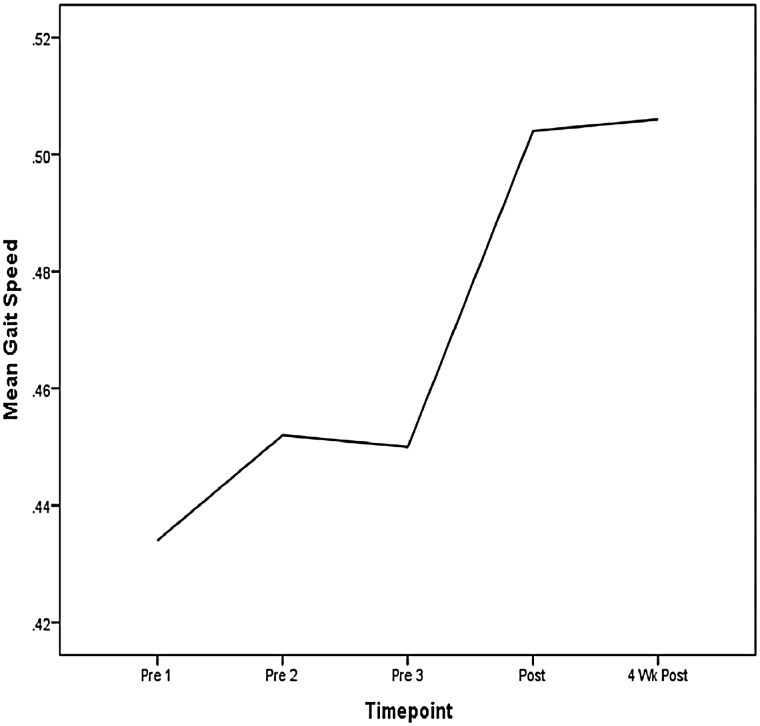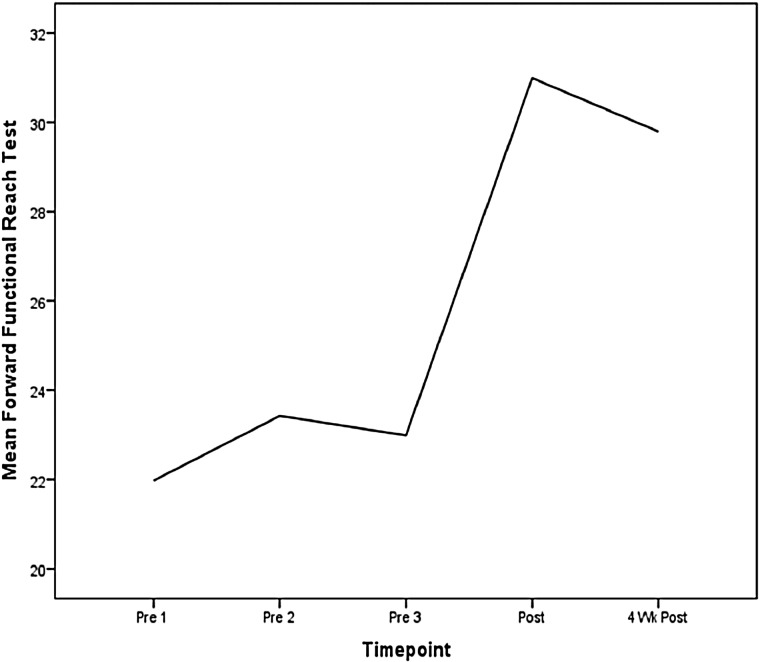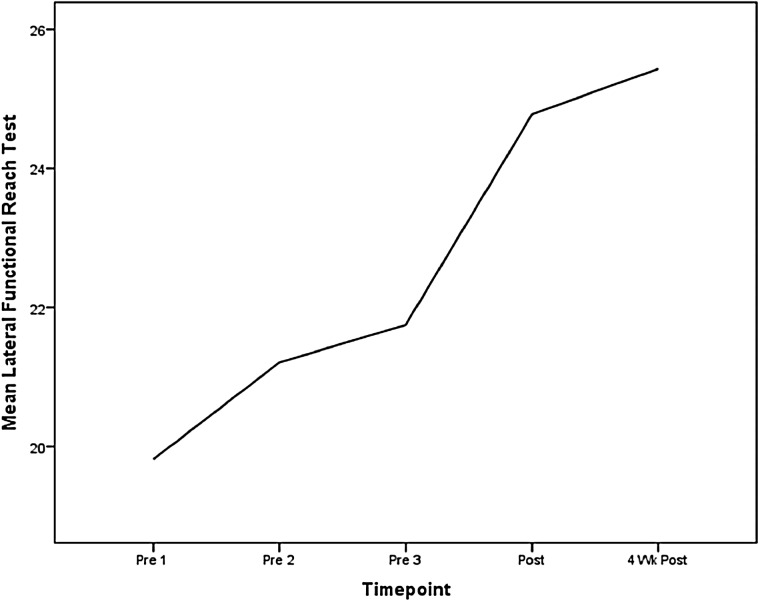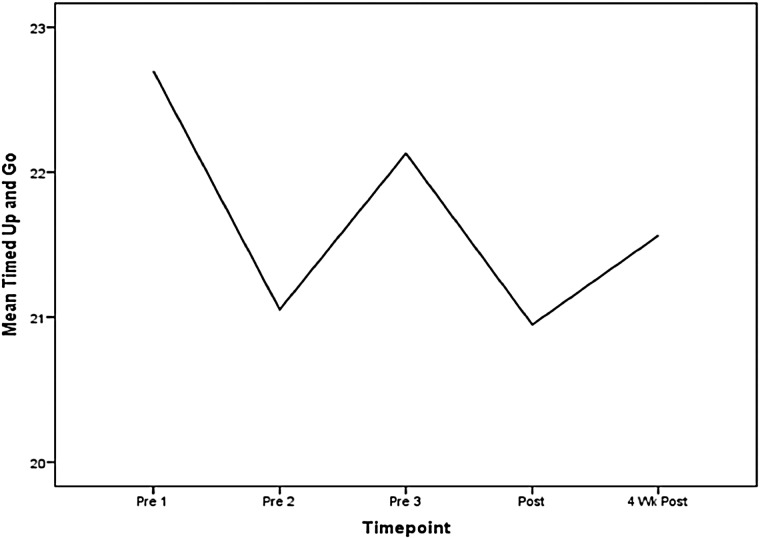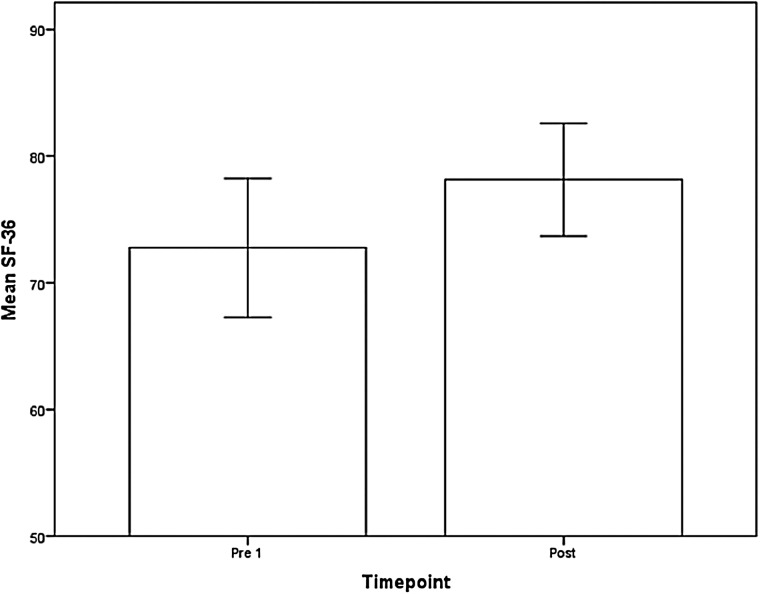Abstract
Purpose
To assess the effects of virtual reality using the NintendoTM Wii Fit on balance, gait, and quality of life in ambulatory individuals with incomplete spinal cord injury (iSCI).
Relevance
There is a need for continued research to support effective treatment techniques in individuals with iSCI to maximize each individual's potential functional performance.
Subjects
Five males with a mean age of 58.6 years who had an iSCI and were greater than one-year post injury.
Methods
An interrupted time series design with three pre-tests over three weeks, a post-test within one week of the intervention, and a four-week follow up. Outcome measures: gait speed, timed up and go (TUG), forward functional reach test (FFRT) and lateral functional reach test (LFRT), RAND SF-36. Intervention consisted of one-hour sessions with varied games using the Nintendo Wii Fit twice per week for seven weeks. Survey data was also collected at post-test.
Results
There were statistically significant changes found in gait speed and functional reach. The changes were also maintained at the four-week follow up post-test. Survey reports suggested improvements in balance, endurance, and mobility with daily tasks at home.
Conclusion
All subjects who participated in training with the NintendoTM Wii Fit demonstrated statistically significant improvements in gait speed and functional reach after seven weeks of training. Given the potential positive impact that the NintendoTM Wii Fit has on functional reach and gait speed in patients with iSCI, physical therapists may want to incorporate these activities as part of a rehabilitation program.
Keywords: Gait speed, Spinal cord injury, Activity specific training, Virtual reality
Introduction
Approximately 55% of people living with a spinal cord injury (SCI) have injuries that affect only part of the spinal cord.1 Functional recovery after an incomplete spinal cord injury (iSCI) can take years and varies significantly with each injury. After injury, disruption of the nerve fiber bundles can cause neuronal communication to be fragmented or distorted leading to complications such as muscle weakness, alterations in movement quality, pain, and changes in muscle tone. Alterations in the quality of movement can include problems with the timing of muscle activity, inefficient muscle activity, difficulty with stance or with weight bearing, and balance deficits.2,3 Ambulation involves the intricate coordination of moving the legs, regulating upright posture, balance and adapting to environmental changes; damage to any portion of this intricate system can upset this delicate balance.3,4
The SCI Information Network's recent update estimates that, by the age of 50, the average lifetime cost for an individual who has sustained an iSCI will exceed a half a million dollars.1 The physical, psychological, and financial impact on individuals with iSCI necessitates continued research aimed to maximize long term functional outcomes. Improved patient outcomes may be further enhanced by mechanisms of neuroplasticity that can be stimulated by different types of physical training.2–4 Theories of neuroplasticity have led to a focus on retraining functional motor strategies with task specific, activity dependent training. For example, to use this strategy to improve ambulation, the focus of therapy is to practice the components of gait as well as the whole gait acitivity. Despite the likelihood of neural reorganization after injury, individuals often develop compensatory movement strategies that impede function and will continue to change as the effects of aging occur. Intensive task specific training is one of the most effective ways to promote neuroplasticity and develop more normalized movement patterns.2–4
Virtual reality
Virtual Reality (VR) is an intervention option that could be used to improve balance and ambulation. VR is defined as an immersive, interactive, multidimensional computer experience, presenting users with the opportunity to engage in environments similar to real events in real time.5 Since reactions to the VR environment are in real time, the simulation provokes real time balance reactions that are required for mobility skills.
Early research studies using VR found improvements in gait velocity and step length in individuals post stroke.6–9 Yang et al.6 examined a group of 24 individuals post stroke to determine the effects of VR training on community ambulation. The VR training group participated in a simulated VR training program for three weeks. The results showed the VR training group improved significantly in gait speed, community ambulation time, and scores on walking ability. The control group demonstrated significant improvement only in community ambulation time. The subjects found the VR training motivational and engaging. Walker et al.7 assessed whether a VR system used in conjunction with body weight supported treadmill training (BWSTT) was a feasible and effective tool for improving ambulation and balance in individuals post stroke. Subjects participated in a four to six week training period of BWSTT coupled with a custom made VR system. The researchers found significant improvements in over ground walking speed and balance as measured by the Berg Balance Scale. Jaffe et al.8 found virtual obstacle training combined with treadmill training improved gait speed in 20 post stroke subjects after only two weeks of training. VR training may be a good tool for motor relearning as it provides realistic, unpredictable scenarios that promote engagement and learning while practicing task specific training of ambulation and balance.
Several studies support the use of the VR based rehabilitation interventions as a potential effective tool for improving function, ambulation, and balance in individuals with stroke, cerebral palsy, and multiple sclerosis.9–12 The research suggests that VR training is a viable option for training. Not only did individuals show functional improvements, they also reported increased motivation. Kizony et al.5 and Belker et al.13 assessed the effects of VR training on sitting balance in individuals with complete SCI. After VR training, subjects were found to have improved functional reach in sitting and increased motivation. To date, there are no studies examining the effects of a low cost consumer based VR system for individuals with iSCI. The purpose of the project was to investigate the effects of the use of an off the shelf VR training system, the Nintendo™ Wii Fit, on gait, balance, and quality of life (QoL) in individuals with iSCI.
Methods
Study design
The study was an interrupted time series design. Pre-testing occurred one time per week for three weeks followed by a seven-week intervention period. Post-testing occurred within one week and at four weeks after the last intervention session. In addition to the testing, the subjects were asked to fill out a short satisfaction survey at post-testing. The survey questions included; what did you like/dislike about the Nintendo™ Wii Fit, and what was the biggest/least benefit to the training. A physical therapist with over 15 years of experience, who volunteered to assist with the study, was provided training and uniform testing protocol to conduct all pre and post testing. This therapist conducted testing only and was not involved in the intervention phase of the study. Subjects were recruited from the physical therapy department at a local rehabilitation hospital. In order to participate in the study all subjects: (1) were diagnosed with an iSCI, (2) required no more than minimal assist to walk 10 meters which is a score of greater than a six on the 0–20 scale of the Walking Index for Spinal Cord Injury II (WISCI-II), a reliable and valid descriptive measure of gait that provides information on assistance level, the use of assistive devices, and bracing14–19 and, (3) were able to tolerate static standing for at least five minutes at a time with no greater than minimal assistance. Subjects were excluded if they had: (1) significant orthopedic impairments or pain that would limit standing or ambulation, and (2) spinal stabilization devices that may limit mobility. Testing occurred at either the local university or local rehabilitation hospital. Both sites had standardized testing areas. At each day of testing outcome measures were administered in a random order to minimize fatigue effects. The Institutional Review Board at Nova Southeastern University, Quinnipiac University and Gaylord Hospital approved this study.
Participants
Six subjects were recruited and tested in a sample of convenience. All subjects had a medical history of a chronic (>1 year post injury) American Spinal Injury Impairment Scale (AIS) D iSCI. Individuals who are categorized as AIS D are described as having strength grades of a three or higher in at least half the key muscles below the level of injury. One subject withdrew from the study because of unrelated medical issues. Before training, the five subjects (mean age 58.6, range 50–64) were assessed with the WISCI-II. All subjects scored greater than a score of 12 on the WISCI-II, this means the subjects had a higher level of ambulation as they could all independently ambulate at least 10 meters. See Table 1 for Demographic Information.
Table 1 .
Subject demographics
| Subject | Age (yrs) | Neurological level | Years since onset | WISCI-II score | Activity level with ADLs and average daily ambulation distance |
|---|---|---|---|---|---|
| 1 | 60 | C6 | 15 | 20 | Independent > 500’ |
| 2 | 59 | C6 | 7* | 20 | Independent > 500’ |
| 3 | 64 | C4 | 1 | 20 | Independent < 500’ |
| 4 | 60 | C5 | 5 | 12 | Independent < 150’ |
| 5 | 50 | L1 | 10 | 19 | Independent < 500’ |
*Subject 2 had two iSCI; date listed is the most recent onset date. All injuries were traumatic in nature.
Outcome measures
Gait speed is an indication of overall walking performance. Gait speed has been assessed in the iSCI population using the Flying Start Method of the 10 Meter Walk Test with good to excellent reliability and validity.14–19
Balance is a multidimensional and complex skill that requires postural stability and mobility. The Timed Up and Go (TUG) measures functional mobility. In individuals with iSCI, the validity of the TUG has been demonstrated by good correlations with other measures such as the 10-Meter Walk Test, 6-Minute Walk Test, WISCI-II, and Berg Balance Scale.15,20,21 The Forward Functional Reach Test (FFRT) and the Lateral Functional Reach Test (LFRT) measure standing balance and postural stability.22–25 Neither of these measures has been utilized to assess balance in populations with iSCI. Reliability and validity of FFRT and LFRT have been established in the older adult and individuals with multiple sclerosis.24,25 Other researchers have used the FFRT to document improvements in postural stability in iSCI.22,23
The RAND SF-36 health measure is a survey that represents eight dimensions of health. These dimensions represent human values that are relevant to a person's QoL and well-being. Reliability and validity have been established in populations with SCI as good to excellent.26–29
Intervention
Each session was one hour, two times per week for seven weeks. The primary author or graduate students previously trained in the intervention protocol supervised all intervention sessions. The intervention was held at either the local university or the subject's home. The sessions consisted of multiple games from the Nintendo™ Wii Fit to promote weight shifting, stability, balance, and coordination.30 Subjects played games focused on components of gait, as described by Behrman et al.31 Games were randomly varied throughout each session. See Table 2 for most commonly played games and the skills each game practice.
Table 2 .
Commonly played Wii Fit games
| Games played | Description | Average # times played per session | Skills practiced during gaming |
|||
|---|---|---|---|---|---|---|
| Dynamic balance | Endurance | Speed | Reaction time | |||
| Penguin plunge | Player weight shifts (WS) laterally at varying speeds and distances | 4 | x | x | x | |
| Segway | Player WS forward to make the segway run, the more the WS the faster the segway runs. Remote is held in both hands to steer | 2 | x | x | x | x |
| Island bike | Player marches on the board to pedal the bike. Remote is held in both hands to steer | 4 | x | x | x | |
| Run | The game is similar to island bike, but on floor. One remote in hand and one remote in front pocket | 4 | x | x | x | |
| Rolling down river | Player must WS in all directions at varying speeds and distances to roll down the river without hitting obstacles | 6 | x | x | x | |
| Tight rope | Player must provide controlled lateral WS to advance with occasional mini squats to jump over obstacles | 2 | x | x | x | |
| Obstacle course | Player is marching on the board to move. It requires variations in speed, WS, and performing sit to stand motion to jump and avoid obstacles | 2 | x | x | x | |
| Ski jump | Player must WS forward with knees flexed to speed down the hill and time a sit to stand motion for a jump | 3 | x | x | x | |
| Skiing | Player must WS forward to speed down the hill while WS laterally to run through the gates | 2 | x | x | x | |
| Tilt table | Player must WS in all directions to drop the balls into the holes | 5 | x | x | x | |
Data analysis
Linear mixed models were used to analyze the interrupted time series data. To assess the effect of the intervention an indicator variable (coded 0 for the three pre sessions and 1 for the two post sessions) was created. To test for a trend, a time variable (coded 0 to 4) was created. In addition, to test for a change in trend after the introduction of the intervention another variable for time since intervention was included. These were all fixed effects and the random effect was the intercept to allow for correlation of repeated measures within the same participant. Cohen's d was used as a measure of effect where the difference between pre- and post-test means was divided by the standard deviation of the pre-test means. The alpha level for statistical significance for this study was set at 0.05.
Results
There were significant intervention effects found for three of the outcome measures, gait speed, FFRT and LFRT, meaning a change between the three pre-sessions and two post-sessions had occurred. There was no statistically significant time effects found for any of the outcomes studied, meaning the change in outcome can not be attributed to trending over the five time points independent of the intervention. Further, there were no statistically significant changes found between each pre test, therefore the average of the pre-tests was considered a stable baseline for the subjects.
There was a significant increase from pre-intervention to post-intervention on gait speed (P = 0.001, d = 0.35, Fig. 1), FFRT (P < 0.001, d = 1.12, Fig. 2), and LFRT (P = 0.001, d = 0.88, Fig. 3). However, there was no change for the TUG (P = 0.25, d = −0.04, Fig. 4). In addition, the SF-36, measured only at the first pre-test and first post-test, was not significant (P = 0.09, d = 0.45, Fig. 5), but there was an apparent increase from pre-test (M = 72.7, SD = 12.2) to post-test (M = 78.2, SD = 10.0).
Figure 1 .
Mean gait speed at each pre-test and post-test*. *Statistically significant difference found between mean pre-tests compared to the mean post-tests (P = 0.001).
Figure 2 .
Mean forward functional reach test at each pre-test and post-test*. *Statistically significant difference found between mean pre-tests compared to the mean post-tests (P < 0.001).
Figure 3 .
Mean lateral functional reach test at each pre- and post-test*. *Statistically significant difference found between the mean pre-tests compared to the mean post-tests (P = 0.001).
Figure 4 .
Mean timed up and go at each pre-test and post-test. No statistically significant difference found between the mean pre-tests compared to the mean post-tests (P = 0.25).
Figure 5 .
Mean (± SEM) short form-36 at first pre-test and post-test one. No statistically significant difference found between the first pre-test and first post-test (P = 0.09).
Discussion
This study indicated a statistically significant change from pre-test to post-test intervention in gait speed after participating in the Nintendo™ Wii Fit games. Subjects maintained the changes in gait speed at the four-week follow up. It is assumed that subjects' gait speeds were positively influenced because they engaged in activity specific training during the Nintendo™ Wii Fit games, which incorporated practice of the components of ambulation. Specifically, subjects practiced reciprocal stepping pattern for propulsion during the Island Bicycle, Run, and Obstacle Course; upright balance during Rolling Down the River, Penguin Plunge, Segway, Ski Jump, and Skiing; and adaptability to respond to demands of the environment during the Penguin Plunge, Rolling down the River, Obstacle Course, and Segway games. As the subjects adapted to and mastered more difficult levels of games, they learned to adapt to the changes in the VR environment. These adaptations mirror real life environmental adaptations that must be made while individuals maintain upright balance such as avoiding a static or moving obstacle and navigating uneven terrain.
After playing the Nintendo™ Wii Fit games, subjects also demonstrated improved forward and lateral functional reach. At the four-week follow up post-test, subjects were able to maintain the significant changes seen in the both outcome measurements. All of the Nintendo™ Wii Fit games challenged upright postural stability by requiring the subject to weight shift repetitively in all directions. This activity specific repetitive practice of postural stability is an important feature of the VR training because of the importance of maintaining postural stability during gait and activities of daily living.
The improvements in gait speed and functional reach in this study support previous research findings on VR training in individuals with neurological conditions.5–13 Specifically, the use of VR based rehabilitation interventions has been found to be an effective tool for improving function, ambulation and balance in individuals with stroke,6–9 cerebral palsy,10,12 SCI,5,13 and multiple sclerosis.11
The improvement in the TUG scores was not statistically significant. Mobility is a complex task requiring multiple skills. While using the Nintendo™ Wii Fit, subjects practiced components of gait, but they did not practice components of mobility specific to functional tasks, such as turns or transferring sit to stand, required by the TUG. This lack of activity specificity may have impacted TUG scores. Further research is needed to evaluate the impact of greater training specificity and longer intervention training with different VR gaming on TUG scores.
Post-test surveys suggest that Nintendo™ Wii Fit training improves mobility and adaptability. After the intervention, all subjects reported improvements in their mobility, walking, or activities of daily living, implying a sense of improvement in the quality of their daily lives. One subject reported ‘I can complete more tasks at home without losing my balance.’ However, these changes were not captured in the SF-36. Questions on the SF-36 address overall health but may not capture small changes in mobility that are significant to the individual. For example, it may not capture the sense of improvement felt after completing a chore with less rest breaks and no loss of balance. The iSCI population also has many factors that impact their overall health status, such as pain, spasticity, and social, emotional and economic influences.32 Although pain, social and emotional well-being is captured by the SF-36, these factors may not have been impacted by this study, limiting changes in health status. Further assessment is needed to capture other factors in a standardized measurement.
Limitations
There were limitations to this study. The sample size was small and was a sample of convenience. All participants were male volunteers over the age of 50 with a higher level of functional mobility (greater than a score of 12 on WISCI-II) which limits the generalizability of the results. There were limitations related to outcome measures. Few measures that assess the complex nature of balance have been found reliable and valid in the iSCI population. The balance measures used in this study only captured a limited amount of information despite being consistently utilized in the literature. The closed ended questions of the SF-36 may not have capture health status changes that were impacted by the intervention. There were some limitations in the VR games used. Although the goal was to use an off the shelf gaming, this product was designed for the general population and may not introduce and practice all mobility skills needed.
Conclusion
Five subjects with iSCI who participated in a seven-week intervention utilizing the Nintendo™ Wii Fit demonstrated positive improvements in gait speed and functional reach. All five subjects were able to maintain these improvements four weeks post training. The Nintendo™ Wii Fit challenges elements of postural control and gait, which physical therapists may want to consider when designing a comprehensive rehabilitation program. The survey reports suggest the intervention was enjoyable and engaging which served as a motivating factor for the subjects to continue to exercise.
Further study is indicated with a larger more diverse sample size, longer follow up, and modifications in the intervention. Possible changes in the intervention module could include different VR games that allow practice of functional tasks (sit to stand or turns) or VR games combined with standardized rehabilitation or home exercise program. Further study is needed of outcome measures to capture changes in QoL and mobility. The standardized and closed-ended questions on the SF-36 did not capture the subjects' subjective statements about their perceived physical abilities and needs further investigation over a longer duration of intervention.
Acknowledgments
Gaylord Hospital and their physical therapy staff who assisted in this project. Jillian Cacopardo PT, MS and Julie Booth DPT, PCS; both were a trained testers for the research project. Kristina Smith PT, PhD and Sheryl Flynn PT, PhD; both provided resources in areas of research in spinal cord injury and virtual reality.
Disclaimer statements
Contributors TW created the research project, design, over saw the intervention, and wrote the manuscript. RF assisted with statistically analysis and writing of the results section. KC provided assistance with statistics and and provided editorial suggestions for the manuscript. MSC provided editorial suggestions for the manuscript.
Conflicts of interest There is no conflict of interested with the authors. A small grant was provided by Quinnipiac University School of of health Science to fund equipment costs (purchasing of the Nintendo Wii Fits (2) for the project).
Ethics approval This research project was approved by the institutional review board for research and ethics at Gaylord Hospital, Quinnipiac University and NovaSoutheastern University.
Funding A small research grant through Quinnipiac University School of Health Science was used to purchase two Nintendo Wii Fit set ups for the project.
References
- 1.Facts and Figures at a Glance [Internet]. Spinal Cord Injury Information Network Website [cited 2014 January 9]. Available from: http://www.spinalcord.uab.edu.
- 2.Field-Fote EC. Spinal cord control of movement: Implications for locomotor rehabilitation following spinal cord injury. Phys Ther 2000;80(5):477–84. [PubMed] [Google Scholar]
- 3.Raineteau O, Schwab ME. Plasticity of motor systems after incomplete spinal cord injury. Nat Rev Neurosci 2001;2(4):263–71. [DOI] [PubMed] [Google Scholar]
- 4.Dobkin BH, Apple D, Barbeau H, Basso M, Behrman A, Deforge D, et al. . Methods for a randomized trial of weight supported treadmill training versus conventional training for walking during inpatient rehabilitation after incomplete traumatic spinal cord injury. NeuroRehabil Neural Repair 2003;17(3):153–67. [DOI] [PMC free article] [PubMed] [Google Scholar]
- 5.Kizony R, Raz L, Katz N, Weingarden H, Weiss PLT. Video captured virtual reality system for patients with paraplegic spinal cord injury. J Rehab Res Develop. 2005;42(5):595–608. [DOI] [PubMed] [Google Scholar]
- 6.Yang YR, Tsai MP, Chuang TY, Sung WH, Wang RY. Virtual reality based training improves community ambulation in individuals with stroke: A randomized controlled trial. Gait Posture. 2008;28(2):201–6. [DOI] [PubMed] [Google Scholar]
- 7.Walker ML, Ringleb SI, Maihafer GC, Walker R, Crouch JR, Van Lunen B, et al. . Virtual reality enhanced partial body weight supported treadmill training post stroke: Feasibility and effectiveness in six subjects. Arch Phys Med Rehabil 2010;91(1):115–22. [DOI] [PubMed] [Google Scholar]
- 8.Jaffe DL, Brown DA, Pierson-Carey CD, Buckley EL, Lew HL. Stepping over obstacles to improve walking in individuals with post stroke hemiplegia. J Rehabil Res Dev 2004;41(3):283–92. [DOI] [PubMed] [Google Scholar]
- 9.Flynn S, Palma P, Bender A. Feasibility of using the Sony Playstation 2 gaming platform for an individual post stroke: A case report. J Neuro Phys Ther 2007;31(4):180–9. [DOI] [PubMed] [Google Scholar]
- 10.Deutsch JE, Borbely M, Filler J, Huhn K, Guarrera-Bowlby P. Use of a low cost, commercially available gaming console (Wii) for rehabilitation of an adolescent with cerebral palsy. Phys Ther 2008;88(10):1196–204. [DOI] [PubMed] [Google Scholar]
- 11.Fulk G. Locomotor training and virtual reality based balance training for an individual with multiple sclerosis: A case report. J Neuro Phys Ther 2005;29(1):34–42. [DOI] [PubMed] [Google Scholar]
- 12.Brien M, Sveistrup H. An intensive virtual reality program improves functional balance and mobility of adolescents with cerebral palsy. Pediatr Phys Ther 2011;25(3):258–66. [DOI] [PubMed] [Google Scholar]
- 13.Betker AL, Desai A, Nett C, Kapadia N, Szturm T. Game-based exercises for dynamic short-sitting balance rehabilitation of people with chronic spinal cord and traumatic brain injuries. Phys Ther 2007;87(10):1389–98. [DOI] [PubMed] [Google Scholar]
- 14.Ditunno JF, Barbeau H, Dobkin BH, Elashoff R, Harkema S, Marino RJ, et al. . Validity of the walking scale for spinal cord injury and other domains of function in a multicenter clinical trial. Neurorehabil Neural Repair 2007;21(6):539–50. [DOI] [PMC free article] [PubMed] [Google Scholar]
- 15.van Hedel HJA, Wirz M, Dietz V. Assessing walking ability in subjects with spinal cord injury: validity and reliability of 3 walking tests. Arch Phys Med Rehabil 2005;86(2):190–6. [DOI] [PubMed] [Google Scholar]
- 16.Bowden MG, Behrman AL. Step Activity Monitor: Accuracy and test-retest reliability in persons with incomplete spinal cord injury. J Rehabil Res Dev 2007;44(3):355–62. [DOI] [PubMed] [Google Scholar]
- 17.Olmos LE, Freixes O, Gatti MA, Cozzo DA, Fernandez SA, Vila CJ. Comparison of gait performance on different environmental settings for patients with chronic spinal cord injury. Spinal Cord 2008;46(5):331–4. [DOI] [PubMed] [Google Scholar]
- 18.Ditunno JF, Ditunno PL, Graziani V, Scivoletto G, Bernardi M, Castellano V, et al. . Walking index for spinal cord injury (WISCI): an international multicenter validity and reliability study. Spinal Cord 2000;38(4):234–43. [DOI] [PubMed] [Google Scholar]
- 19.Ditunno PL, Dituno JF. Walking index for spinal cord injury (WISCI-II): scale revision. Spinal Cord 2001;39(12):654–6. [DOI] [PubMed] [Google Scholar]
- 20.van Hedel HJA, Wirz M, Curt A. Improving walking assessment in subjects with incomplete spinal cord injury: responsiveness. Spinal Cord 2006;44(6):352–6. [DOI] [PubMed] [Google Scholar]
- 21.Lemay JF, Nadeau S. Standing balance assessments in ASAI D paraplegic and tetraplegic participants: concurrent validity of the berg balance scale. Spinal Cord 2010;48(3):245–50. [DOI] [PubMed] [Google Scholar]
- 22.Lynch SM, Leahy P, Barker SP. Reliability of measurements obtained with a modified functional reach test in subjects with spinal cord injury. Phys Ther 1998;78(2):128–33. [DOI] [PubMed] [Google Scholar]
- 23.Hornby TG, Zemon DH, Campbell D. Robotic-assisted, body weight supported treadmill training in individuals following motor incomplete spinal cord injury. Phys Ther 2005;85(1):52–66. [PubMed] [Google Scholar]
- 24.Duncan PW, Weiner DK, Chandler J, Studenski S. Functional reach: A new clinical measure of balance. J Geront 1990;45(6):M192–7. [DOI] [PubMed] [Google Scholar]
- 25.Frzovic D, Morris ME, Vowels L. Clinical tests of standing balance: performance of persons with multiple sclerosis. Arch Phys Med Rehabil 2000;81(2):215–21. [DOI] [PubMed] [Google Scholar]
- 26.Forchheimer M, McAweeney M, Tate DG. Use of the SF-36 among persons with spinal cord injury. Am J Phys Med Rehabil 2004;83(5):390–5. [DOI] [PubMed] [Google Scholar]
- 27.Lin MR, Hwang HF, Chen CY, Chiu WT. Comparisons of the brief form of the world Health organization quality of life and short form-36 for persons with spinal cord injuries. Am J Phys Med Rehabil 2007;86(2):104–13. [DOI] [PubMed] [Google Scholar]
- 28.Haran MJ, Lee BB, King MT, Marial O, Stockler MR. Health status rated with the medical outcomes study 36-item short-form health survey after spinal cord injury. Arch Phys Med Rehabil 2005;86(12):2290–5. [DOI] [PubMed] [Google Scholar]
- 29.Lee BB, Simpson JM, King MT, Haran MJ, Martial O. The SF-36 walk wheel: a simple modification of the SF-36 physical domain improves its responsiveness for measuring health status change in spinal cord injury. Spinal Cord 2009;47(1):50–5. [DOI] [PubMed] [Google Scholar]
- 30.Deutsch JE, Brettler A, Smith C, Welsh J, John R, Guarrera-Bowlby P, et al. . Nintendo Wii Sports and Wii Fit game analysis, validation, and application to stroke rehabilitation. Top Stroke Rehabil 2011;18(6):701–19. [DOI] [PubMed] [Google Scholar]
- 31.Behrman AL, Bowden MG, Nair PM. Neuroplasticity after spinal cord injury and training: an emerging paradigm shift in rehabilitation and walking recovery. Phys Ther 2006;86(10):1406–25. [DOI] [PubMed] [Google Scholar]
- 32.Bonanno GA, Kennedy P, Galatzer-Levy IR, Lude P, Elfstrom ML. Trajectories of resilience, depression, and anxiety following spinal cord injury. Rehabil Psych 2012;57(3):236–47. [DOI] [PubMed] [Google Scholar]



